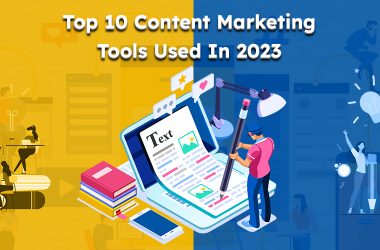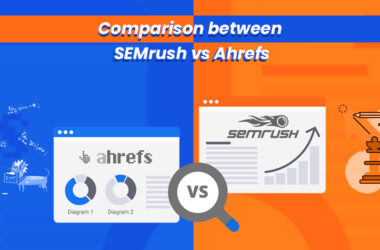A Data Scientist is in authority for extracting, operating, pre-processing, and generating forecasts obtainable of data. In command to do so, one necessitates several statistical software and software design languages.
Here in this article we have tried to bring a well-gathered evidence about data science tools used by Data Scientists to perform their data operations. We will comprehend the strategic features of the tools, benefits they provide and comparison of various data science tools.
Introduction To Data Science
Data Science has appeared out as one of the utmost widespread arenas of the 21st Century. Corporations hire Data Scientists to support them gain visions and understanding about the market and to enhance their goods.
In doing so satisfactorily one needs a number of software and programming languages for Data Science to fix the entire day in the approach he desires. We will go over a few of these data science tools that operates to analyze and generate forecasts.
Data Science take account of gaining the significance from data. It is all about understanding the data and processing it to extract the specific assessment out of it.
Data Scientists are the data specialists who can shape and scrutinize the enormous quantity of data.Data Scientists exerts as an arbitrators and are fundamentally accountable for evaluating and controlling an enormous extent of unstructured and structured data.
The tasks that data scientists carry out recognizing significant queries, gathering data from diverse data sources, data association, transforming data to the solution, and communicating these results for improved corporate judgments.
Top Data Science Tools
Here is a record of 10 finest data science tools that most of the data scientists use.
-
SAS
It is one of the most prominently utilized data science tools which are un ambiguously planned for carrying out statistical operations. SAS is a secure source exclusivetool that is used by huge establishments to investigate data. SAS utilizes base SAS software design language for execution of statistical modeling.
It is extensively employed by experts and corporations functioning on reliable commercial software. SAS offers numerous statistical libraries and tools that you as a Data Scientist can use for modeling and organizing their data.
While SAS is extremely consistent and has robust sustenance from the company, it is exceedingly costly and is merely used by bigger industries. Also, SAS stakes in appraisal with some of the new contemporary tools which are open-source.
In addition, there are a number of libraries and packages in SAS that are not accessible in the base pack and can call for an expensive upgradation.
-
Apache Spark
Simply Spark or Apache Spark is a supreme analytics engine and it is the maximum utilized Data Science tool. Spark is un ambiguously deliberated to handle batch processing and Stream Processing.
It originates with several APIs that enable Data Scientists to style recurrent access to data for Machine Learning, Storage in SQL, etc. It is an enhancement over Hadoop and can perform 100 spells faster than Map Reduce.
Spark has numerous Machine Learning APIs that can support Data Scientists to create potent calculations with a particular set of data.
Spark does better than other Big Data Platforms in its capability to operate streaming data. This states that Spark can exercise real-time data as compared to other analytical tools that practice solitary historical data in groups.
Spark deals with numerous APIs that are programmable in Python, Java, and R. But then again the utmost potent combination of Spark is with Scala programming language that is based on Java Virtual Machine and is client-server in nature.
Spark is exceedingly effectual in mass management which makes it considerably superior to Hadoop as the second one is simply worn for storage. It is this cluster management arrangement that consents Spark to exercise requests at an extraordinary speed.
-
BigML
A different and extensively used Data Science Software is Big ML, it is responsible for a completely headstrong, cloud-based GUI background that one can use for processing Machine Learning Algorithms. Big ML arrange for standardized software with cloud computing in lieu of commerce necessities.
By utilizing BigML tools the corporations can custom Machine Learning algorithms from corner to corner for different domains of their firm. For instance, one can employ this one specific software across for budget anticipation, risk analytics, and product innovation.
BigMLfocusses in extrapolative modeling. It procedures a wide-ranging variation of Machine Learning algorithms like assembling, cataloging, time-linespredictions, etc.
It organizes to practicea stress-free command-line interfaceusing Rest APIs and one can build a free account or a premium account according to their data needs. It agrees interactive visualizations of data and offers you with the facility to carry acrossgraphicplans on your mobile or IOT devices.
What’s more, BigMLapproaches with severalcomputerizationapproaches that can assist you to systematize the regulating of hyper-parameter models and even automate the workflow of reusable scripts.
-
D3.js
Javascript is mostly used as a client-side scripting language. D3.js, a Javascript library lets you to sortcommunicating visualizations on your web-browser. By means ofa number of APIs of D3.js, one can use numerous functions to craft dynamic visualization and analysis of data in browser.
An additionaldominant feature of D3.js is the practice of animated transitions. D3.js makes documents dynamic by permitting updates on the customer side and vigorously using the modification in data to reveal visualizations on the browser.One can poolD3.js with CSS to build illustrious and transitory visualizations that will support you to execute customized graphs on web-pages.
In general, it can be an extremely convenient software for Data Scientists who are operational on IOT centeredstrategies that necessitate client-side collaboration for visualization and data processing.
-
MATLAB
MATLAB is a multi-paradigm arithmetic computing setting for processing mathematical data. It is a closed-source software that enables matrix functions, algorithmic execution and statistical displaying of data. MATLAB is supremely andextensively used in quite a lot oftechnical disciplines.
In Data Science, MATLAB is utilized for simulating neural networks and unclear logic. By the MATLAB graphics library, you can craftprevailing visualizations. MATLAB is likewise used in image and signal processing. MATLAB has already established itself as anenormously versatile tool for Data Scientists as they can challenge all the glitches, from data cleaning and analysis to more innovative Deep Learning algorithms.
In addition, MATLAB’s uncomplicated integration for enterprise applications and embedded schemes makes it an ultimate Data Science tool.
-
Excel
In all probabilityit is the best Data Analysis tool used far and wide. Microsoft advanced Excel customarily for worksheet calculations and these days, it is extensivelyutilized for data processing, visualization, and complex calculations. Excel is a staggeringly powerful logical tool for Data Science. Despite the fact that it has been the outmoded tool for data analysis, Excel still is far more operational than any other identical tool.
Excel comes with an in-built functions such as countless formulae, tables, filters, slicers, etc. if an individual holds a certain bit of understanding and knowledge,may customizetasks and formulae by Excel. Despite the fact, Excel is not for computingmassive Data, but then again it remains aquintessentialselection for creating a powerful data spreadsheets andvisualizations.
One can go forward tolink SQL with Excel and that can be utilized to operate and evaluate data. Majorly Data Scientists practice Excel for data cleaning as it offers a headstrong GUI setting to pre-process facts and figureswith no trouble.
With the proclamation of ToolPak for Microsoft Excel, it has become so effortless to calculate complex analysis. On the other hand, it still diminishes in contrast with considerably more cutting-edge Data Science tools like SAS. Generally, on a trivial and non-enterprise level, Excel is the supreme tool for data analysis.
-
Ggplot2
Ggplot2 is an unconventional data visualization package for the R programming language. The inventersgenerated this software to swap the built-in graphics package of R and it practicespotent commands to produce illustrious visualizations. Ggplot2 is the utmostand widespread library that Data Scientists employ for fashioning visualizations from analyzed data.Ggplot2 is portion of tidy verse, a package in R that is designed for Data Science.
Unique way in which ggplot2 is greatlyenhanced than all the other data visualizations is aesthetics. With ggplot2, Data Scientists can generate customized visualizations in order to take part in heightened storytelling.
Using ggplot2, one can deduce data in visualizations, enhance text labels to data points and increasecomplexity of graphs. Individuals cansimilarlygeneratea number of styles of maps such as choropleths, cartograms, hex-bins, etc. It is the best used data science tool.
-
Tableau
Tableau is a Data Visualization toolwhich isfilled with powerful graphics to create interactive visualizations. It is concentrated on engineeringemployed in the pitch of corporateacumen.
The primary and vital feature of Tableau is its aptitude to edge with databases, spreadsheets, OLAP (Online Analytical Processing) cubes, etc. In company with these highlighteddetails, Tableau has the capability to visualize geographical data that helps for plotting longitudes and latitudes in maps.
In consort with visualizations, you can furtherpractice these data tools to analyze data. Tableau arises with a vigorous community and you can share your discoveries on the online platform. Even though Tableau is enterprise software, it comes with a free version called Tableau Public.
-
Jupyter
Project Jupyter is an open-source tool based on I-Python for facilitatingcreators in building open-source software and know-hows interactive computing. Jupyterropesin several languages like Julia, Python, and R. It is a web-application softwarethat is used for scripting live code, visualizations, and presentations. Jupyter is anextensivelywidespread tool that is considered to address the necessities of Data Science.
It is an inflexible environment over which Data Scientists can accomplish all of their accountabilities. It is in addition a dominant tool for storytelling as a number ofdemonstration features are present in it.
Using Jupyter Notebooks, workers can execute data cleaning, statistical calculation, visualization and generate predictive machine learning models. It is 100% open-source and is, for that reason, it is totally at no cost.
There exist an online Jupyteratmosphere called Collaboratorythattracks on the cloud and stores the data in Google Drive.
-
Matplotlib
Matplotlib is a scheming and visualization library technologically created for Python. It is the furthermostwidely held tool for creäting graphs with the evaluated data. It is primarily used for plotting difficultdisplayswith simple lines of code. Employing this tool, one can create bar plots, histograms, scatterplots etc.
Matplotlib has quite a lot ofindispensablesegments. One of the most popularly used modules is pyplot. It deals with a MATLAB like interface. Pyplot is likewise an open-source substitute to MATLAB’s graphic modules. Matplotlib is a number one tool for data imaginings and it is used by Data Scientists above other existing tools.
As a matter of fact, NASA used Matplotlib for illustrating data visualizations during the landing of Phoenix Spacecraft. It is also an ideal tool for beginners in learning data visualization with Python.
Which Company Is Best for Data Science
-
IBM
IBM is an American multinational technology corporation with its headquarters in Armonk, New York. It is widespread and operational in over 171 countries, it is one of the world’s leadingcompanies across the world.
IBM is identified for its inventions and embraces the record for maximum US patents produced by a corporate for 28 successive years. Some of their distinguisheddiscoveriesconsist of the floppy disk, hard drive, and relational database, SQL programming language, automated teller machine (ATM), the UPC barcode, and lots more.The average salary of a Data Scientist at IBM is $134,179 per annum.
Notable Projects
IBM Cloud Pak for Data: Unemployed data is one of the maintests in scaling AI-powered policymaking. IBM Cloud Pak for Data platform permits organizations to join and access the data silos without moving them. It make straightforward data access by automatically discovering and curating them to deliver actionable information access to its users.
IBM Watson Studio: IBM Watson Studio permits data scientists, analysts, and software developers, to build and track AI models. It supports to computerize AI lifespans and speed time and bring together open-source frameworks with IBM for code-based and visual data science.
-
Wipro
Wipro is recognized for its information technology, consulting, and business progressionfacilities. It was established on 29 December 1945 and has its center of operations in Bangalore, India. With more than 221,000 workers, it is ranked the 9th biggestestablishment in India.
Wipro utilizes a hugepower to expose its workers to hackathons and summits, which permits their data science professionals to work together with the topmost experts in the business. They also buoy up the expansion of their data science expertsover courses in alliance with the finestinstitution of higher education. The average salary of a Data Scientist at IBM is $108,924 per annum.
Notable Projects
Data Science Acceleration (DSA) Platform
The Data Science Acceleration (DSA) Platform empowersnative data scientists (non-data science specialists) to custom data and analytics via an automation work table and recyclable modules. It builds anaccessible workflow by leveraging open-source expertisesurrounded by a cloud environment.
IQNxt
Wipro’s IQNxt framework arrange forestablishments with a full assessment of data, a data governance arrangement, and a custom-builtoperational roadmap. The elucidation is easy to set up and permitsestablishments to store up to 30% in expenditures with a 93% upgrading in data quality.
-
Cloudera
Cloudera is a software development business that offers enterprise data cloud which is manageable via a payment fee. The Cloudera podium is erected as on open source technology and practices data analytics and machine learning to produceawareness from data. It workscrossways hybrid, multi-cloud, and on-premises architecture.Cloudera was set up in 2008 with its head office in Santa Clara, California. Powered by the open-source community, Cloudera is aunique fastest-increasing cloud businesses.Out there hastening digital transformation for the world’s largest enterprises. The average salary of a Data Scientist at Cloudera is $132,308 per annum.
Notable Projects
CDP Private Cloud
CDP Private Cloud is a hybrid data platform that delivers powerful transactional, analytics, and machine learning workloads. It also provides the option of traditional or elastic analytics and scalable object storage. It enables data scientists with true data and workload mobility by providing them with consistent data security and governance across all public and private clouds.
Cloudera Operational Database
Cloudera Operational Database is an operational database that enables developers to quickly build future-proof applications that can handle data evolution over time. It also automates and simplifies database management as well as seamless integrations with other Cloudera data platform services.
Splunk
Splunk is the world’s innovative data-to-everything platform that produces tools for probing, checking, and investigating machine-generated data through a web-style interface. Splunk was founded in 2003 and has its headquarters in San Francisco, California, and has 23 offices worldwide. Splunk has been familiar as a Leader in the 2021 Gartner Magic Quadrant for Security Information and Event Management (SIEM) for above 8 years now.The average salary of a Data Scientist at Splunk is $165,773 per annum.
Notable Projects
Splunk Insights
Splunk Insights is an analytics software that can evaluate and scrutinizepossible threats by ingesting incident logs from several bases. It is exclusively valuable and targeted on the road to smaller organizations like schools and universities.
Splunk Industrial Asset Intelligence
Splunk Industrial Asset Intelligence is an intelligence tool that minesfactsand figures from Industrial Internet of Things (IIoT) data from a number of possessions and presents acute alerts to its users.
-
Numerator
Numerator is a data and tech business headquartered in Chicago, Illinois. The firm is acknowledged for its ground-breaking market research methods which amalgam exclusive data with cutting-edge technology to build exclusive insights. The main stream of the Fortune 100 companies across the globe are clients of Numerator.The average salary of a Data Scientist at Splunk is $147,479 per annum.
Notable Projects
Purchase Based Audience Targeting
Numerator’s procurementsamalgam audience aimingpermitsestablishments to generate niche objectiveswith first-party procurement data through intelligent modeling. This supportsto form a target audience more professionally and permitspromoters to emphasizeprecisely on them.
Suggested Blog:- Top Ten Email Marketing Software
Summary
We have seen in a sharp lime light that how does data science necessitates a vast array of tools. The data science software are for scrutinizing data, crafting aesthetic and collaborating visualizations and generating powerful predictive models using machine learning algorithms.
Most of the data science tools deliver complex data science actions in one place. This makes it easier for the operator to device functionalities of data science devoid of having to inscribe their code from scratch. Also, close by are quite a few additional tools that provide to the application realms of data science.









